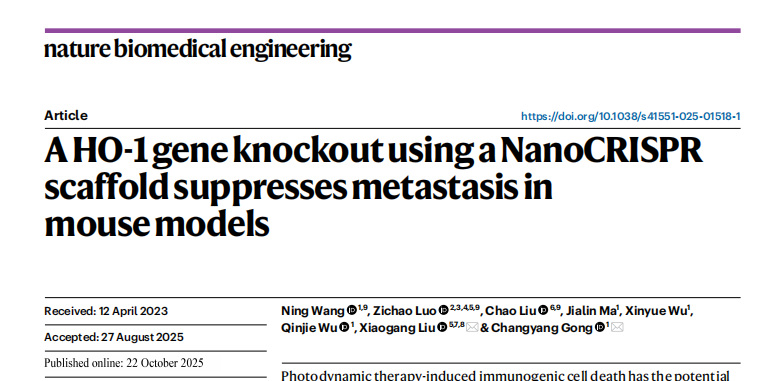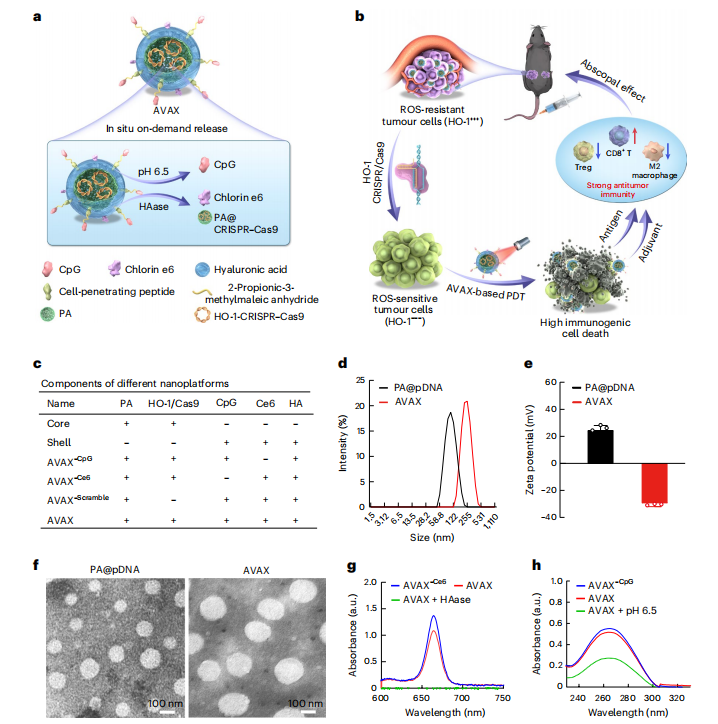[Literature Review] Knocking Out the HO-1 Gene Makes Tumor Cells More
![]()
Photodynamic therapy (PDT) induces immunogenic cell death (ICD) mediated by reactive oxygen species (ROS), leading to the release of endogenous tumor-associated antigens, neoantigens, and damage-associated molecular patterns. As a non-invasive in situ therapy, PDT has been shown to trigger the generation of an autologous vaccine. However, ROS not only reduces ICD yield but may also contribute to tumor recurrence and distant metastasis as potential seed cells. Therefore, eliminating tumor resistance to ROS and achieving heritable ROS sensitivity is crucial.
Recently, a collaborative study by Sichuan University and the National University of Singapore published in Nature Biomedical Engineering titled "A HO-1 gene knockout using a NanoCRISPR scaffold suppresses metastasis in mouse models" reported that their designed Nano CRISPR scaffold (a nanocarrier-based CRISPR gene editing system) achieved a gene editing efficiency of 20.15%, without compromising the gene editing capabilities or cytotoxic functions of key immune cells. By knocking out the HO-1 gene , the Nano CRISPR system transformed the heterogeneous phenotype of tumor cells into a ROS-sensitive state, thereby enhancing the efficacy of ICD and improving the outcomes of in situ vaccination.

Recently, a collaborative study by Sichuan University and the National University of Singapore published in Nature Biomedical Engineering titled "A HO-1 gene knockout using a NanoCRISPR scaffold suppresses metastasis in mouse models" reported that their designed Nano CRISPR scaffold (a nanocarrier-based CRISPR gene editing system) achieved a gene editing efficiency of 20.15%, without compromising the gene editing capabilities or cytotoxic functions of key immune cells. By knocking out the HO-1 gene , the Nano CRISPR system transformed the heterogeneous phenotype of tumor cells into a ROS-sensitive state, thereby enhancing the efficacy of ICD and improving the outcomes of in situ vaccination.

Original link: https://doi.org/10.1038/s41551-025-01518-1
Spotlight
1. ROS Susceptibility
The Nano CRISPR system achieves permanent knockout of HO-1, effectively enhancing tumor susceptibility to ROS without adversely affecting key immune cells.
2. Superior Therapeutic Efficacy
Under near-infrared (NIR) irradiation, the in situ autologous nano-vaccine (AVAX) treatment group demonstrated a tumor growth inhibition rate of 93%, significantly outperforming the AVAX-Ce6+L group (83%).
3. Potent Immunological Properties
When combined with laser irradiation and anti-PD-L1 antibody therapy, the Nano CRISPR platform induces robust antitumor immunity and long-term immunological memory in melanoma models.
01
Design and Validation of AVAX
Photodynamic therapy (PDT) induces immunogenic cell death (ICD) mediated by reactive oxygen species (ROS), leading to the release of endogenous tumor-associated antigens, neoantigens, and damage-associated molecular patterns. As a non-invasive in situ therapy, PDT has been shown to trigger the generation of an autologous vaccine. However, ROS not only reduces ICD yield but may also contribute to tumor recurrence and distant metastasis as potential seed cells. Therefore, eliminating tumor resistance to ROS and achieving heritable ROS sensitivity is crucial.
The designed AVAX completely releases CpG and Ce6 in the presence of hyaluronidase and in weakly acidic environments, demonstrating its ability to elicit a hierarchical response to both the intra- and extracellular tumor microenvironment.
The designed AVAX completely releases CpG and Ce6 in the presence of hyaluronidase and in weakly acidic environments, demonstrating its ability to elicit a hierarchical response to both the intra- and extracellular tumor microenvironment.

Figure 1. Design and Characterization of the AVAX Nanovaccine
02
AVAX Overcomes ROS Tolerance
AVAX enables efficient delivery of the CRISPR-Cas9 system into tumor cells and achieves targeted knockout of HO-1, a key gene identified for ROS tolerance.
In B16F10 melanoma and LL/2 lung cancer models, a single intravenous injection combined with NIR irradiation resulted in a 20.15% HO-1 gene editing efficiency in tumor cells. This enhanced PDT efficacy, induced an autologous vaccine effect, and activated long-lasting antitumor immune responses. This strategy permanently alters tumor cell sensitivity to ROS through genetic modification.

Figure 2. AVAX Overcomes Tumor Resistance to Reactive Oxygen Species
03
Immune Activation and Biodistribution of AVAX In Vitro
NIR-irradiated AVAX enhances ICD in tumor cells, subsequently activating bone marrow-derived dendritic cells (BMDCs) and potentially promoting antigen presentation.
Moreover, AVAX was predominantly taken up by tumor cells in vivo, facilitating HO-1 knockout, while showing minimal impact on BMDCs, T cells, and macrophages, with no significant toxicity observed.

Figure 3. ICD Activation by AVAX and Its Preferential Uptake in Tumors
04
Antitumor Efficacy of AVAX In Vivo
Under identical NIR irradiation conditions, the AVAX treatment group achieved a 93% tumor growth inhibition rate, significantly outperforming the AVAX-Ce6+L group (83%) and other treatment groups that showed no notable tumor suppression.
Additionally, ROS accumulation in the AVAX group was markedly higher than in other comparative groups. These results collectively demonstrate the excellent antitumor efficacy of AVAX in vivo.

Figure 4. Enhanced Tumor Suppression and ROS Accumulation Mediated by AVAX In Vivo
05
Prevention of Tumor Recurrence
In primary tumor resection experiments, the combination of AVAX with L&αPD-L1 significantly reduced tumor recurrence rates, with 5 out of 6 experimental mice maintaining a tumor-free survival period exceeding 75 days. In rechallenge experiments, this group exhibited the slowest tumor growth, confirming that the combined therapy effectively suppresses recurrence and induces durable immune memory.

Figure 5. AVAX Combined with L&αPD-L1 Significantly Suppresses Tumor Recurrence and Induces Immune Memory
Summary
This study successfully reversed the genetic tolerance of tumor cells to ROS through a core–shell structured Nano CRISPR system, achieving "genetic sensitization" of tumors. The approach inhibited tumor growth by up to 93% in vivo and significantly suppressed tumor recurrence when combined with L&αPD-L1 therapy.
This strategy opens new avenues for personalized tumor immunotherapy. Future efforts may focus on optimizing delivery systems and safety profiles, integrating gene editing with immune activation mechanisms to develop more efficient and precise therapeutic solutions for tumors.
This strategy opens new avenues for personalized tumor immunotherapy. Future efforts may focus on optimizing delivery systems and safety profiles, integrating gene editing with immune activation mechanisms to develop more efficient and precise therapeutic solutions for tumors.
EDITGENE specializes in providing customized knockout cell line as its core service. Leveraging an advanced CRISPR/Cas9 system, we consistently equip research teams with key tools to bridge the gap between basic research and clinical applications. Contact us today to customize your gene-editingsolutions and accelerate your project!















![[Quality Share] Efficient Generation of CRISPR Point Mutations Using Donor Template Strategies](/uploads/20250328/ESzk5OC49wpxIHVv_3cbfa5e98ea1d238127fe23c72b0f4b2.png)
![[Literature Review] Decoding the Latest Nature Paper from David Liu’s Team: How Gene Editing Teaches Cells to “Ignore Errors”](/uploads/20250527/bL2GJjteMDvzmZys_53c82bdd67704fe0e159246934f924ee.png)

Comment (4)